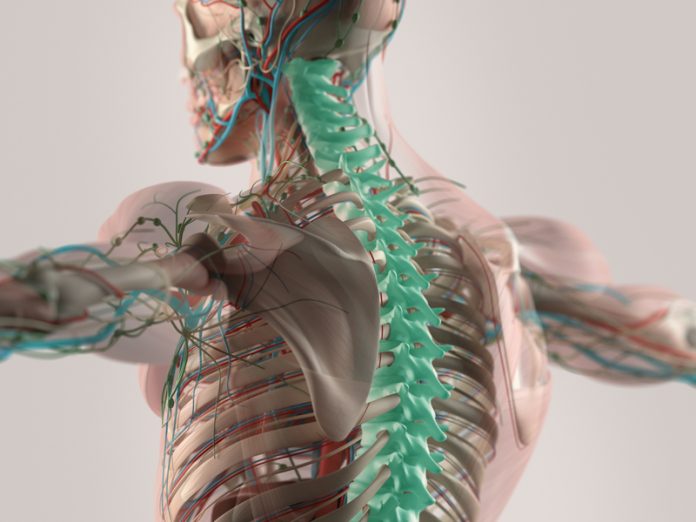Cecilia Van Cauwenberghe from Frost & Sullivan’s TechVision Group provides a comprehensive overview work-related musculoskeletal disorders, focussing on the path towards absolute prevention
Covering any injury, damage or disorder of the joints or other tissues in either the upper limbs or the lower limbs, as well as, the back, work-related musculoskeletal disorders (WRMSDs) can be categorised as work-related upper limb disorders (WRULDs), work-related lower limb disorders (WRLLDs) and work-related low back disorders (WRLBDs), respectively. In all cases, a heterogeneous group of conditions is observed.
WRULDs may affect any region of the neck, shoulders, arms, forearms, wrists and hand, leading to potential affections such as tendonitis, carpal tunnel syndrome, osteoarthritis, vibration white finger and thoracic outlet syndrome, among many other complications lacking so well-defined signs and symptoms, implicating tenderness, aches and pain, stiffness, weakness, tingling, numbness, cramp and swelling. Major causes associated with WRULDs are repetitive work, uncomfortable working postures, sustained or excessive force, long time carrying out the same task, the poor working environment including inappropriate temperature, lighting and humidity, as well as, work overload involving work pressure, job demands, lack of work breaks.
WRLLDs affect the hips, knees and legs. Among the most commonly recognised, hip and knee osteoarthritis, knee bursitis, meniscal lesions and tears, stress fracture and reaction injury and varicose veins are remarkable. Major causes are related to repetitive kneeling and squatting, fixed postures without a break and frequent jumping.
WRLBDs constitute a major health concern in the developed world, involving both low back pain and low back injuries. According to the paper published by Leclerc, 2016, some negative effects of WRMSDs related to specific occupational exposures are mainly short-term issues. However, for WRLBDs, long-term effects are dramatically important and may lead to complete work disability.
Operational risk factors
Prolonged exposure to ergonomic risk factors may lead to MSDs. Among the work actions potentially causing MSDs, those most commonly observed are exerting excessive force, repetition of movements, awkward postures or unsupported positions that can compress nerves and irritate tendons, static postures held for long periods of time that can restrict blood flow and provoke muscle atrophy, quick bending and twisting motions, compression from grasping sharp edges, vibration, cold temperatures, insufficient recovery time.
Furthermore, the accumulation of years of exposure to occupational demands must be taken into consideration. Klussmann et al., 2017 analysed manual handling operations (MHO) as one of the principal risk factors for WRMSDs, following different methods to estimate the risk validated in regard to criterion validity, reliability and utility.
Absolute prevention – leading-edge ergonomic science and innovation
Obligations and recommendations
The prevention of WRMSDs risks is not only a socioeconomic and health advice but also an employer’s responsibility, commitment and obligation within the occupational risk assessment. Overall, the risk evaluation should include detection of the work tasks involving greater probability of derive in a WRMSD, ergonomic analysis of these work tasks and situations, critically analysing workstations, activity, work environment and operators’ complaints, evaluation of biomechanical, organisational and psychological WRMSDs risks.
The European Agency for Safety and Health at Work (EU-OSHA) proposes a series of preventive actions consisting of drawing up ergonomic solutions to decrease or ideally eliminate those evaluated risk factors. The checklist comprises the ergonomic design and proper use of work tools, appropriate product design, ergonomic layout of the workstations and the physical work environment, optimised manufacturing configuration, ergonomic pattern of the activity implying alternation of repetitive and non-repetitive tasks, different muscle groups demands, short and frequent breaks, short time rotation in different workplaces, settle adjusting periods and shifts and naturally, training and education at individual and organisational levels.
Smart textiles and monitoring wearables
In a Frost & Sullivan Research Service, Van Cauwenberghe, 2016, introduces the concept of ‘smart healthcare’ solutions, as a predominant piece under the umbrella of ‘smart cities’, capable of monitoring the health status of the employees in favour of the early detection of any signs and symptoms and the corrective measures before the effects become irreversible. Indeed, according to another Frost & Sullivan publication, Van Cauwenberghe, 2017, emphasises the role of advanced materials becoming a remarkable and promising field among the foremost innovative areas of medical care at the workplace by synergistically combining principles of intrinsic sensor technology with material engineering.
Ranjan, 2017, in another Frost & Sullivan Research Service, depicts a workplace ecosystem comprising a set of wearables aiming for preventing WRMSDs. A wearable jacket holding sensors in the sleeves can be incorporated to warning about movements, vibrations or harsh environment via a tactile undershirt to operators. The adaptable mesh network allows each element of the ecosystem to communicate with one another in order to meet plant operator safety guidelines. The main advantages of smart monitoring in preventing WRMSDs are real-time feedback, increased awareness and peer-to-peer communications in the internet of things (IoT) systems, which are expected to significantly boost safe practices. The undershirt can be also designed to monitor the employee’s health status in real-time by integrating biosensors to measure heart rate, breathing, skin response, muscle movements and overall spatial position. Pressure sensors included in the insoles of work shoes can help to determine the force applied by the worker and the load on the shoe.
The use of emerging sensing technologies at workplace represents a more universal approach to health status monitoring focused on integrating cutting-edge technologies to deal with healthcare data acquisition and their utilisation for WRMSDs prevention. Indeed, vanguard technology innovations play the central role in providing accurate data to be analysed, visualised and shared in real time; thus, improving results. Furthermore, cost-saving and time-effective collaborative relationships among workers, employers, insurers and healthcare organisations, are improving, paving the way for a better health and quality of life for workers.
Acknowledgements
I would like to thank all contributors from industry involved with the development and delivery of this article and Frost & Sullivan’s staff from the TechVision Group.
Further reading
European Agency for Safety and Health at Work, 2010. OSH in figures: Work-related musculoskeletal disorders in the EU – Facts and figures. https://osha.europa.eu/en/tools-and-publications/publications/reports/ TERO09009ENC .
Klussmann, A., Liebers, F., Gebhardt, H., Rieger, M.A., Latza, U. and Steinberg, U., 2017. Risk assessment of manual handling operations at work with the key indicator method (KIM-MHO) – determination of criterion validity regarding the prevalence of musculoskeletal symptoms and clinical conditions within a cross-sectional study. BMC musculoskeletal disorders, 18(1), p.184.
Leclerc, A., 2016. Work-related physical exposure and low back pain. Occup Environ Med, pp.oemed-2016.
Ranjan, B., 2017. Sensor Innovations Transforming Industry 4.0. Smart, Connected Sensors Create Opportunities in Smart Factories. Frost & Sullivan Research Service. http://www.frost.com/d7e5 .
Van Cauwenberghe, C., 2016. Technologies Empowering Smart Healthcare: The Optimal Synergy Between Leading-edge Hi-Tech and Digital Innovation. Frost & Sullivan Research Service. http://www.frost.com/d74f .
Van Cauwenberghe, C., 2017. Emerging Sensor Technologies Transforming Medical Diagnostics. The Optimal Synergy between Leading-edge Science and Medical Innovation. Frost & Sullivan Research Service. http://www.frost.com/d74f .
Cecilia Van Cauwenberghe, PhD, MSc, BA
Associate fellow and senior industry analyst
TechVision Group, Frost & Sullivan











